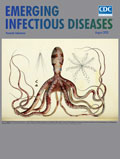
Volume 26, Number 8—August 2020
Dispatch
Prolonged Persistence of SARS-CoV-2 RNA in Body Fluids
Jiufeng Sun1, Jianpeng Xiao1, Ruilin Sun1, Xi Tang1, Chumin Liang, Huifang Lin, Lilian Zeng, Jianxiong Hu, Runyu Yuan, Pingping Zhou, Jinju Peng, Qianlin Xiong, Fengfu Cui, Zhe Liu, Jing Lu, Junzhang Tian , Wenjun Ma, and Changwen Ke
, Wenjun Ma, and Changwen Ke
Abstract
We prospectively assessed 49 coronavirus disease cases in Guangdong, China, to estimate the frequency and duration of detectable severe acute respiratory syndrome coronavirus 2 RNA in human body fluids. The prolonged persistence of virus RNA in various body fluids may guide the clinical diagnosis and prevention of onward virus transmission.
In December 2019, coronavirus disease (COVID-19) caused by a novel coronavirus, severe acute respiratory syndrome coronavirus 2 (SARS-CoV-2), emerged in Wuhan, China (1,2). As of April 1, 2020, the virus had expanded to 195 countries, and >820,000 confirmed cases with >40,000 deaths had been recorded (3–6).
Clinically, the confirmation of SARS-CoV-2 infection relies on detection of virus RNA in various body fluids. The World Health Organization recommends taking upper and lower respiratory samples simultaneously during the acute phase of infection to detect virus RNA. Recent studies reported a persistent shedding of SARS-CoV-2 in upper respiratory and intestinal samples (7,8). However, the frequency with which SARS-CoV-2 RNA can be detected in body fluids and the period during which it remains detectable are not well understood. A detailed understanding of the dynamics of the early stages of SARS-CoV-2 infection is needed to inform diagnostic testing and prevention interventions, because existing evidence is based only on observations from case reports. We recruited hospitalized patients with COVID-19 from 2 designated provincial emergency hospitals for emerging infectious diseases in Guangdong, China, and tested specimens by real-time reverse transcription PCR (rRT-PCR) to estimate the duration of the detection of SARS-CoV-2 RNA in various body fluids, using an accelerated failure time (AFT)–based modeling study.






















.png)











No hay comentarios:
Publicar un comentario